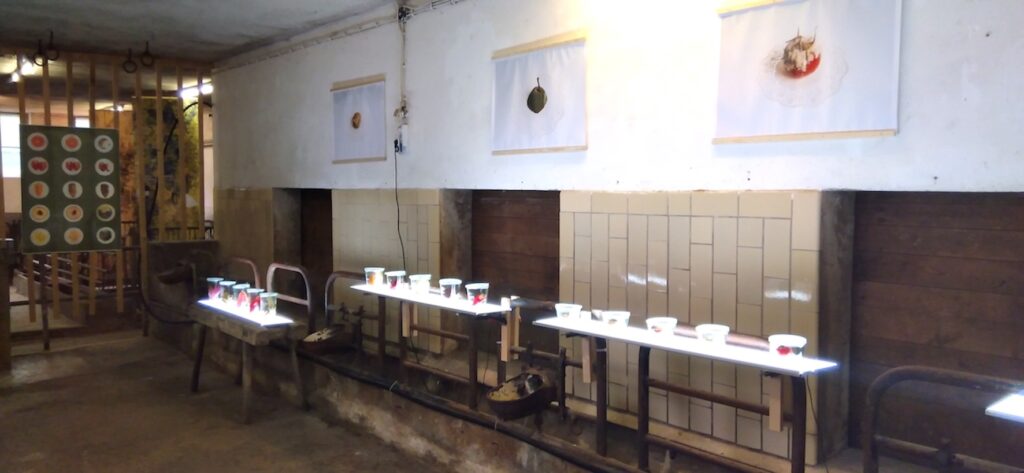Guest Blog by UNESCO Chair on Heritage Futures Cornelius Holtorf.
It was a series of changes of plan that generated my acquaintance with Werner Lorke and Bennett Encke’s “Fungi Furs” art in Reusten near Tübingen and with Kathleen Ryan’s “bad fruit” artworks in Hamburg.

Figure 1: Performing fungi at the Fungi Furs exhibition at Süddeutscher Kunstverein in Reusten near Tübingen.
Lorke and his son Encke explore the temporality of fungi in various contexts, including food. They know, and show in their photographs and physical demonstrations, that fungi are decomposers that break down organic material. Does this make their art post-human rather than human art? And what could this even mean? Lorke and Encke also know that fur-like fermentation or coating with cultivated edible mold can make meat, dairy and plant products, among other foods, last longer and preserve: things regenerate—when something is lost, something else will emerge. As a matter of fact, I only came to attend the opening of Fungi Furs after the original plan to spend the weekend with friends elsewhere had collapsed.

Figure 2: This new building now stands on the site of Dieter Roth‘s Schimmelmuseum in Hamburg.
Werner Lorke pointed me to Kathleen Ryan’s retrospective exhibition in Hamburg. Originally, my intention had been to see what is left of Dieter Roth’s Schimmelmuseum in Hamburg. Since the 1960s, Roth (1930-1998) had been developing transient art, for example using sugar and chocolate, in a decaying house that was eventually demolished in 2004 and subsequently replaced by a modern building. For how long will the new structure stand here? Does transient art call for palliative conservation? Today, there is a virtual visual documentation of the house on the website of the Roth Museum. Apparently, there is also a dedicated room in the new building containing a few things that could be placed there. I didn’t get in there though, as the planned tour was cancelled and plans changed once again.

Figure 3: Bad fruit by Kathleen Ryan at the Hamburger Kunsthalle, using mixed materials.
Instead, I followed up on Kathleen Ryan and went to the Hamburger Kunsthalle. Ryan (born 1984) presents here a number of art works made from various durable materials, depicting decaying “bad” fruits—carefully taken care of and protected inside the museum space. Curiously, her work is about the short-term and the long-term at the same time. With a background in archaeology and art, Ryan explores the interface of decline, decay, renewal and regeneration. Her oversized bad fruits are reclaimed by colourful mould and black flies, just as she had reclaimed (re-used) technical artefacts like car bonnets and semi-precious stones in the production of her art. Should her artworks now be reclaimed as beacons of sustainability? Can the world simultaneously experience decay and renewal, too?
Today more than ever, it seems that the only thing that is genuinely permanent, if not timeless, is change, regeneration, and transformation. Let us preserve this idea for the future, except of course we may not be capable: temporalities of change resist conservation.
PS: See also the Boston Harvard Museum of Natural History’s Fruits in Decay exhibit, drawing on its wonderful collection of plants (and marine invertebrates) made from glass. Previously, there was a Rotten Apples exhibit in the same place. Nothing ever stays the way it was, not even decay…
Cornelius Holtorf UNESCO Chair on Heritage Futures
